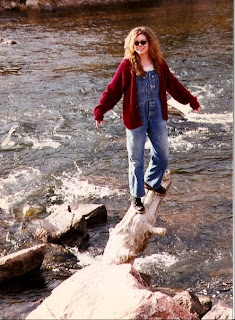I hate making year end lists. I'm a slow listener, for starters. And other than superficial run-ins with the radio, I tend to listen to one thing at a time. Once I get into some music enough to write about it, I don't look up much until the writing's done.
I reviewed about 22 albums in 2011. Since my I-Tunes lists about 22 new album releases a month, I've deeply listened to (and this is being wildly generous to myself) at most 1/12th of the music high profile enough for a (let's call it) national conversation about the state of our music. Since about half of what I've listened to is regional and not likely to be listed in I-Tunes new releases, it's safe to guess I'm listening to less than 1/24 of what we might talk about in a year-end review. So, while I'm sometimes asked to do those things, I've never seen it as a gauge of what mattered most that year. It's what mattered most to me, which is, at best, an argument for the importance of some things others might have overlooked or undervalued.
But, then, I do have a desire to sum up the year, in some way that makes sense in terms of how I work. I started writing about music as an act of rebellion--against the cultural biases of both the academy that surrounded me in grad school and against the rock snobbism that immediately tried to steal away the liberation rock music gave me in the first place. I wrote in defense of the way the music taught me my feelings mattered. I wrote hoping that others would fight for their passions, too.
Not surprisingly, I suppose, my first piece for publication was about how music intersected with racism on my college campus. Specifically, I wrote an article for Rock & Rap (then Roll) Confidential about the connection between our campus's "Plantation Week" and the lily-white radio format of every FM station in listening distance. Little Steven's "Sun City" record, featuring dozens of black artists I only slightly knew alongside my favorite white (primarily male) artists, put me in our school's protest march alongside our campus's African-American Student Union, got me involved in the fight against South African apartheid and gave me my first article.
As I think about how to sum up 2011, I think about how little things have changed, in some ways. Yesterday, at the "America I Am" black history exhibit at Union Station, I experienced a vivid but unnecessary reminder, realizing that my wife and I were the only white folks visiting the entire two hours we were there. (I should mention the exhibit was moderately busy, even crowded at points, throughout those same two hours.) We may have an African-American President, but it still feels like white America doesn't recognize its debt to (dependency on, inextricable relationship with) black America.
I also think about loss... I seemed to know more people than ever before (this increases as we get older, yeah?) who lost loved ones this year. Having lost a best friend in 2010, it was a year of sad anniversaries for me. And, of course, with the economy continuously in some stage of crisis, it was another year of economic loss and the threat of even more loss. Most painfully for me personally, my friends and I lost our friend Eduardo Loredo (incidentally on my birthday). Eduardo was a great kid, 16-years-old, who was prepped for a heart transplant two years ago but could never even get on a waiting list because he was too poor and he happened to be living in Kansas rather than his home state of Chihuahua....
But all years bring horrific amounts of pain, and what seemed more unique about 2011 was the level of life affirming rebellion. The year started with uprisings in Tunisia and Egypt that have spread to at least 18 different countries, in the process helping to create the state of Southern Sudan. In February, protests erupted in Wisconsin, bringing firefighters and farmers alongside students and public employees in defense of collective bargaining rights. In September, Occupy Wall Street would inspire similar protests in hundreds of cities across America (and some count over 80 countries around the world) with the concept "We are the 99%."
For the first time in my own political experience (and I think it's fair to say American history), the concept of political unity I'd learned from rock and rap records excited the American imagination--challenging our mind-numbing array of subjective class relationships and getting us much closer to talking about the relationship between what Adam Smith (we don't even need to go to Marx) called the "masters" and the "workers." "I ain't your fortunate son" meets "come together."
Now, as the various conflicting groups brought together by Occupy fight through their differences and try to keep the movement rolling, I don't know how this will all turn out. In one respect, it doesn't matter. We've grasped a new sense of politics in America this year, and that idea is too true to die.
So, I figured I'd take my list of records I wrote about this year (and a few I didn't) and turn it into my Occupy 25. First and foremost, these records were my favorites because of the way the music stood out from other music I heard. Still, it's worth noting that each of these records affirms the fundamental concept of Occupy in some fundamental way--"We are the 99%!"
The 25 Records that Occupied My 2011 (order, roughly chronological) --
El Compa Chuy, Con Estilo--No nonsense set of corridos (by definition on behalf of the 99%) by the Sinaloan cowboy who brought Eduardo Loredo out on stage with him and posted the Kansas City, Kansas boy's story on his Facebook.
Lupe Fiasco, Lasers--"The Words I Never Said" and hit single "The Show Goes On" predated Occupy but serve as a primer on the basis for unity.
Gerardo Ortiz, Morir Y Existo En Vivo--though also from Sinaloan roots, this young Pasadena, California singer brings a hip hop sensibility to the production of his gorgeous, haunted corridos while singing with the voice of a man well beyond his years.
Michael Fracasso, Saint Monday--His "Working Class Hero" is as ominous and precise as the George Reiff bassline that drives it. Offering up the lines "There's room at the top, they're telling you still/But first you must learn how to smile as you kill" in a kind of musical equivalent to sculptured relief. The Lennon classic is an apt touchstone for this collection of Beatle-catchy rockers from one of Austin's finest, a record that even finds its way to a break-up duet with Patty Griffin in "Ada, OK."
Me Like Bees, Me Like Bees--The young Joplin band that made my year, drawing on their mutual love of White Stripes and Modest Mouse but, to my ears, doing something more fundamental--fusing the heaviest heartland rock impulses with utterly-contemporary, incendiary funk.
Howard Iceberg & the Titanics, Welcome Aboard! The Kansas City Sessions (7 volumes)--Gorgeous collection, beginning to end, featuring more than 50 regional artists and including "Hotel Alhambra," as beautiful and epic as any song I heard this year--hinting at the death of Western Civilization as we know it while focusing on images of such beauty that it becomes a tribute to the human spirit.
Jason Isbell & the 400 Unit, Here We Rest--a country-tinged record that dreams of freedom, at least at one point from the perspective of a returning vet, and draws on Southern Soul and the sounds of New Orleans as essential parts of that dream.
Julie C, Sliding Scale--Seattle rapper serving up Twista-swift rhymes with brilliant, eclectic production--touching on every conceivable front of the war of the rich against the poor and promising to find her way out of “the same old scenarios.”
Ace Hood, "Hustle Hard"--the hit single from an album I certainly should have picked up, a 2011 "Workingman's Blues" after the jobs are gone and they ain't ever coming back.
Grupo Innovacion, Lo Mas Importante--Booker, Texas-based norteno vets serve up gorgeous, romantic melodies with....saxophone!
Stewart Francke, Heartless World--35 of Detroit's finest musicians (black and white, that matters here), including Mitch Ryder, join this blue-eyed soul singer in a search for redemption. Even Springsteen shows up to the opening call for unity.
Mr. Marco's V7, Sparkin' Yo Mama--The Arab spring expressed through free jazz with heavy metal hard edges, maniacal and gorgeous.
Raphael Saadiq, Stone Rollin'--Retro Soul made urgent--at times, Sly and the Family Stone urgent.
Rise Against, Endgame--Opener "Architects" is a punk metal, proactive version of "Imagine." After 12 songs of such boundlessly energetic rock challenges, the question and answer lyric "Is this the end of yesterday? Lord I hope so" invites not only a laugh but an "amen."
Gilbere Forte, "Born in '87"--Flint, Michigan rapper aiming for (and nearly hitting) the intensity of Eric B & Rakim's "Follow the Leader," promising to live "the life that Martin Luther had dreamed."
Jason Aldean and Ludacris, "Dirt Road Anthem (Remix)"--When you're dream is "hitting easy street on mud tires," you don't have to add "we are the 99%."The Hearers, In Dreamlife--This 10 member band lives nationwide, but the sound comes together in a basement in Merriam, Kansas they've dubbed Merriam Shoals. That works...because the punk-psychedelic vision that comes out of that basement is wide enough to take in the history of rock and soul and reach for the heavens at the same time (as it does quite directly on "A Star Can Be Your Home").
The Low Anthem, Smart Flesh--This Rhode Island group spent a fair amount of time occupying with Occupy. Though its music is rarely overtly political, its focus on an eclectic mix of roots music certainly comes out of deep listening to those who have the least in society, and the band's consistent focus on the beauty of our vision as well as the obstacles in its path reflect the hopeful contradiction that fuels the 99% movement.
Tom Morello (The Nightwatchman), World Wide Rebel Songs--Not surprisingly, Morello gets Zeitgeist Title of the Year Award, and the music here strives valliantly to deliver on that promise, most brilliantly on the title track, "Save the Hammer for the Man" and "Black Spartacus Heart Attack Machine."
Sara Swenson & the Pearl Snaps, Never Left My Mind--Exquisite music about (and I mean what Springsteen once called "a diamond hard focus" on) our need for each other, nowhere more beautiful than on the long dark night of "Brother."
The Bottle Rockets, Not So Loud--The writers of "Welfare Music," "1000 Dollar Car" and "Kerosene," all included in this acoustic collection, long ago established where their hearts lay. But the introductory tribute to Doug Sahm before a cover of "I Don't Want to Go Home"--"I thought he was a superstar"--is a fine 99% moment (that before the song's meditation on the balance between freedom and responsibility).
Rod Picott, Welding Burns--Heartland rock as beautiful and austere as a west Kansas horizon line, about poetic dreamers who also happen to be welders, yeah, and factory workers and sheet rock hangers and petty criminals.
Asa, Beautiful Imperfection--This Nigerian rocker's "The Way I Feel" serves as a 2011 rewrite of Langston Hughes' "A Dream Deferred," and the album argues repeatedly for payment due on a check that reads "liberty and the pursuit of happiness."
Ariana Gillis, Forget Me Not--Like Asa actually, who also debuted in 2009, both of this bravest of new songwriters' albums talk frankly about the costs of war and the need for love, and they do it anything but simplistically. Hard to beat the messy realities of this record's "Dream Street" for illustrating that point, but every gem offers another crucial piece to a very necessary mosaic.
Victor & Penny, Antique Pop--The birth of American pop through a playful, ebullient 21st Century lens. And what emerge as the central themes? Love, yeah, and diversity and justice and unity.
















